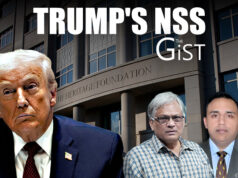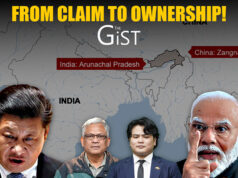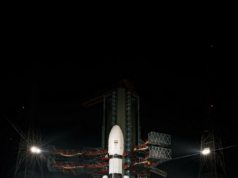As the biennial Aero India show begins in Bengaluru on Monday, all eyes will be on what aerospace and defence companies from across the globe are able to offer to the Indian armed forces under the current policies that emphasise Make in India and atmanirbharta (self-reliance). With various studies estimating India’s defence spending to range between 400 and 425 billion dollars over the next five years, the opportunities are limitless for both local and foreign OEMs and the upcoming MSME sector in India.
Eyeing Indian Aerospace And Defence Pie
In the same week when defence majors compete to pitch different platforms to the Indian military in Bengaluru, two major military aviation powers in the world would be trying to impress upon Prime Minister Narendra Modi and his senior national security team the importance of buying their platforms. Modi and team will be in France and the United States between February 10 and 14. According to all indications, both the Macron government and the Trump administration will be pushing India hard to source some of the major defence platforms from French and American OEMs. While some programmes are already in advanced stage of negotiations, others are yet to be explicitly put on the table by the two countries. Modi will be in Paris on February 10-11 followed by a two-day working visit to Washington, DC between February 12 and 14.
Rafale, Scorpene Contracts
The procurement of 26 Rafale-M (Marine) aircraft, manufactured by the French company Dassault Aviation, for the Indian Navy is final. It awaits the mandatory approval from India’s Cabinet Committee on Security (CCS). The Naval Group in France is also hopeful of clinching the contract to supply three more Scorpene class submarines to the Indian navy. India’s own shipyard Mazagaon Docks Ltd will build them if the deal goes through. So, the French defence industry has something concrete to look forward to from India soon. Both the contracts are likely to be signed in March or April.
What Next After MQ-9B?
By contrast, after the signing of the nearly $3 billion contract with the U.S. Government for Tri-Service procurement of 31 MQ-9B Sky/Sea Guardian High Altitude Long Endurance Remotely Piloted Aircraft System (RPAS) in October 2024, no major procurement is immediately in the offing from the United States. However, with President Trump openly putting pressure on New Delhi by publicly stating he expects India to buy more from American defence companies, India will have to find ways to balance Trump’s demand with its own policy of reducing defence imports.
So what can India offer the United States immediately? It can decide to accelerate discussions on buying and then manufacturing in India the Stryker armoured infantry combat vehicle for India’s mechanised forces. There is also the possibility of India agreeing to procure more C-130 J transport aircraft and the P8-I maritime patrol aircraft that also doubles up as anti-submarine warfare and ISR platform from U.S. manufacturers. Both these platforms are already in service with the Indian Air Force (IAF) and the Indian Navy respectively.
U.S. Firms Eye Jet Deal
Negotiations are, however, likely to get trickier with the U.S. when it comes to two long-term plans that the Indian Air Force has. One, the procurement of 114 multi-role fighter aircraft and aero engine for India’s own indigenous Advance Medium Combat Aircraft (AMCA). History tells us Indian strategic decision makers have always avoided buying fighter jets from the United States, although the reasons and context on why U.S. was not a favoured source for combat jets each time the need arose may have varied. Two U.S. aerospace majors—Boeing and Lockheed Martin—have been attempting to sell the F-15 EXs and the upgraded F-16s, now rechristened F-21 to the IAF for most of this century but to no avail so far.
Aero Engine: Import Or Indigenous?
Similarly, given the prevarication and an almost two-year delay in supplying the required number of F-404 turbofan jet engines to Hindustan Aeronautics Limited (HAL), manufacturer of the Tejas Light Combat Aircraft (LCA) Tejas mark 1A, by the U.S. engine maker General Electric, India is not sure if it can consider an outright import of GE engine for its AMCA programme and instead opt to develop an engine on its own with help from any of the major aeroengine makers. Of course, GE is also in final negotiations stage with HAL to co-produce the F-414 in India with 80 per cent transfer of technology to be fitted on the Tejas Mark 2 fighters.
The French Safran Aircraft Engines company has on the other hand offered to co-develop and co-manufacture an aero engine in India in collaboration with India’s Defence Research and Development Organisation (DRDO) for the AMCA programme. The offer has been on the table for nearly two years. However, this programme—estimated to cost anywhere between six to eight billion dollars—will be decided on strategic considerations rather than just technological parameters, those in the know point out. The French will also perhaps like to push India in buying additional Rafale fighters for IAF as a quid pro quo even if it means manufacturing the aircraft in India in the near future.
There is no doubt a geostrategic view will be at play in deciding which country to go with in co-designing and co-manufacturing an aero engine in India. The race is clearly on between France and U.S. to clinch the big contract even as 900 exhibitors, including 54 foreign OEMs, 52 domestic manufacturers vie for attention at Aero India 2025 in Bengaluru from Monday.
Nitin A. Gokhale is a media entrepreneur, one of South Asia's leading strategic affairs analyst and author of over a dozen books so far on military history, insurgencies and wars.
Starting his career in journalism in 1983, he has since led teams of journalists across media platforms.
A specialist in conflict coverage, Gokhale has covered the insurgencies in India’s North-East, the 1999 Kargil conflict and Sri Lanka’s Eelam War IV between 2006-2009.
Gokhale now travels across the globe to speak at seminars and conferences, and lecture at India’s premier defence colleges. He has founded three niche portals, Bharatshakti.in, stratnewsglobal.com and Interstellar.news.




